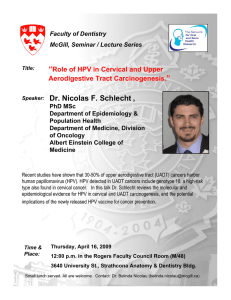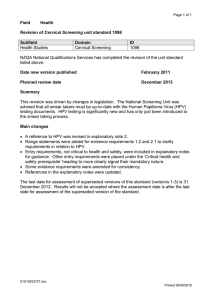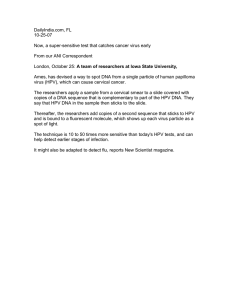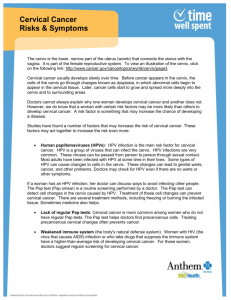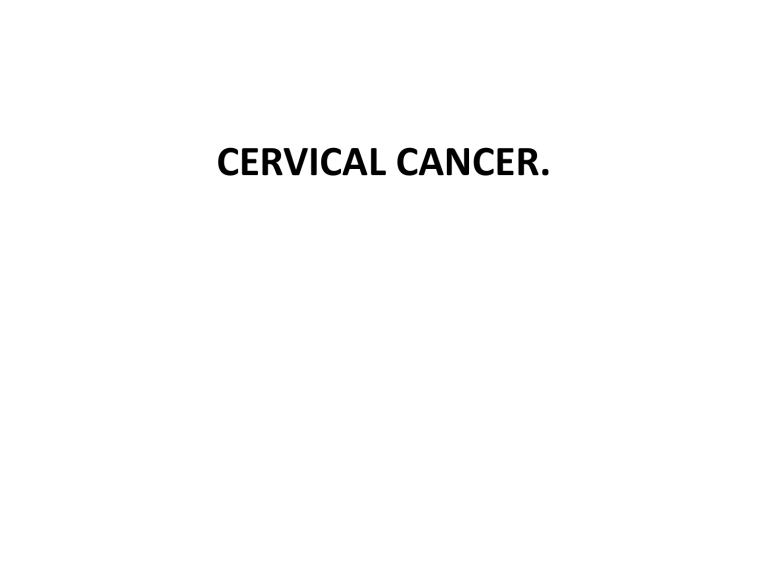
CERVICAL CANCER. CERVICAL CANCER. • Def. Cancer of the uterine cervix is a neoplasm(can spread to other part of the body) that can be detected in the early it is curable stage and can be detected by performing the Papnicolaou test (Pap smear). • Cervical cancer is almost always caused by human papillomavirus (HPV) infection. • Incidence is high in women aged 35 yrs or older who: Began sexual activity in puberty and Have had multiple partner Other risk factors includes: • Low socio – economy status. • Poor prenatal and postnatal care. • Women with multiple genital infections e.g. herpes, trichomonas infection, gonorrhea etc. • Cigarette smoking. PROTECTIVE AGAINST INVASIVE CERVICAL CANCER. • Take beta carotene food(group of red, yellow and orange pigment). • Eat carrots and green vegetables. • Take food rich in Vitamins C and A. • Types of barrier contraception.(condom) • Partner to go for circumcision PATHOPHYSIOLOGY. • Abnormal bleeding is the most common sign. • Initially bleeding is thin, watery, blood- tinged vaginal discharge. • Progresses to spotting and frank(spontenously) bleeding • Other signs and symptoms are: • Prolonged or intermittent menstrual periods • Contact bleeding after intercourse • Anemia in presence of chronic blood loss Advance signs are: • Odour • Pain in the lower back, legs and groin • Lower extremity edema • Difficult voiding, urgency, or hematuria • Rectal tenesmus(feeling of incomplete defecation) and rectal bleeding • When symptoms appear, the CA has usually progresses beyond its early stages. • Squamous cell CA (arises from the surface lining of the ectocervix, ) accounts for 95% of all invasive tumor. • Adenocarcinoma of the cervix(arises within glands located in the endocervix spreads by direct extension to: The vaginal wall. Laterally into the parametrium toward the pelvic wall. Antero-posteriorly into the bladder and rectum. Metastases to the pelvic lymph nodes are more common than those to distant nodes. Risk factors • Smoking. • High number of full-term pregnancies. • Long-term use of oral contraceptives. • Women who have used oral contraceptives ("the Pill") for 5 years or more have a greater risk of cervical cancer than women who have never used oral contraceptives. The risk is higher after 10 years of use. MULTIDISPLINARY PLAN • Surgery • Radiation therapy • Chemotherapy NURSING ASSESSMENT ( signs and symptoms) • Perineal area: Unusual bleeding or vaginal discharge Prolonged or intermittent menstruation periods Contact bleeding after intercourse Skin irritation or excoriation Malodorous discharge(smelling) Signs and symptoms (cont.) • Hematology signs Anemia Fatigue • Renal signs: Difficult voiding Urgency • Intestinal signs Rectal tenesmus (desire to defecate) Bleeding • Comfort: Pain in lower back, legs, and groin Lower extremity edema Prevention • Identify the risk factors that increase cervical cancer: • HPV Infection • The most common cause of cervical cancer is infection of the cervix with human papillomavirus (HPV. • HPV infections that cause cervical cancer are spread mainly through sexual contact. • Women who become sexually active at a young age and who have many sexual partners are at a greater risk of HPV infection and developing cervical cancer. • Immunization • Preventing HPV infection by Avoiding sexual activity: Using barrier protection or spermicidal gels:. • Getting an HPV Vaccine:. The vaccines protect against infection with these types of HPV for 6 to 8 years. • It is not known if the protection lasts longer. The vaccines do not protect women who are already infected with HPV. • Screening • Regular pelvic exams and Pap tests help find abnormal cells in the cervix before cancer develops. • Diet • These may include eating fruits and vegetables, exercising, quitting smoking, or taking certain medicines, vitamins, minerals, or food supplements.
